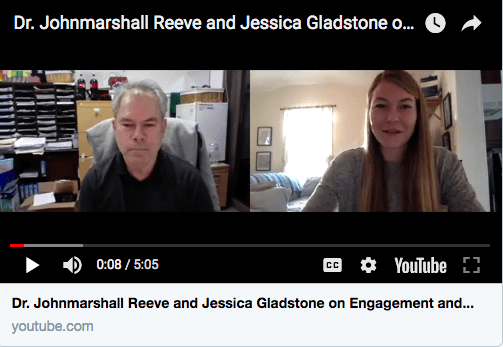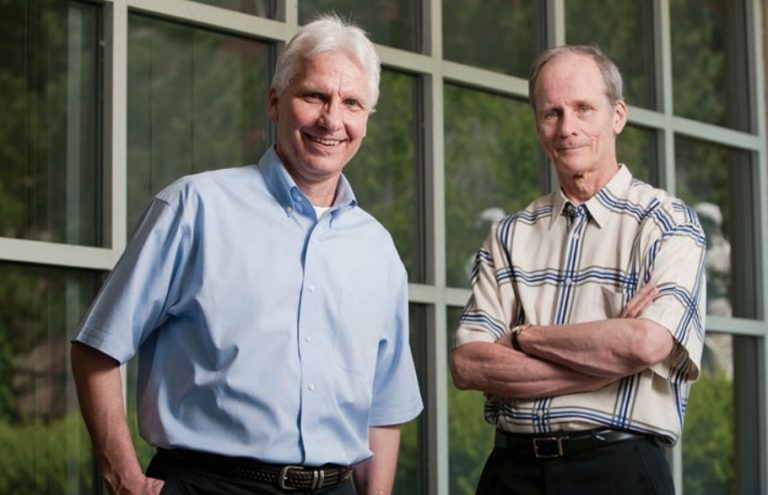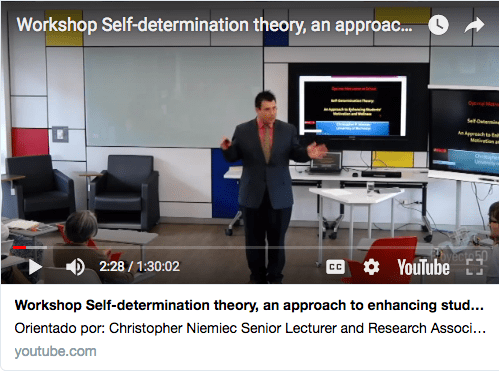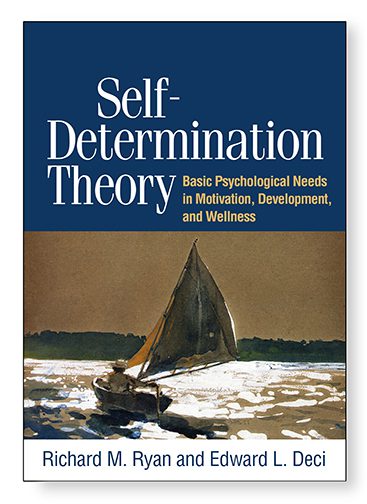
Check out Dr. Johnmarshall Reeve, #SDTFaculty, 5-minute video interview on #StudentEngagement and #motivation…
https://youtu.be/7DA95RAM_PM via @YouTube


Check out Dr. Johnmarshall Reeve, #SDTFaculty, 5-minute video interview on #StudentEngagement and #motivation…
https://youtu.be/7DA95RAM_PM via @YouTube


#SelfDeterminationTheory…how it all began. APA Interview with Richard Ryan and Edward Deci
The Intrinsic Motivation of Richard Ryan and Edward Deci
http://psyciq.apa.org/intrinsic-motivation-richard-ryan-edward-deci/

Questions about #Education #ClassroomMotivation #SelfDeterminationTheory?
Get answers from Christopher Niemiec’s recent workshop at Proyecto 50, Universidad EAFIT, Medellin, Colombia

This long-awaited book by Richard M. Ryan and Edward L. Deci is now available around the globe!
North and South America
Use discount code: AFSDT
Click here to order
* discount code will auto-generate when using link above
UK & Europe
Use discount code: GUIL3
Click here to order
Australia and New Zealand
Use discount code: SDT20.
Click here to order
Asia Pacific
Use discount code: GUIL3
The book distributor Taylor & Francis-Asia Pacific doesn’t have a purchase website, but you can order your book via email at: marketing@tandf.com.sg and mention discount GUIL3
This book is also available on Amazon

Advance Online SDT Articles:
Halvari, H., Healey, J., Olafsen, A. H., Byrkjeland, R., Deci, E. L., Williams, G. C. (2016). Physical activity and motivational predictors of changes in health behavior and health among DM2 and CAD patients. Scand J Med Sci Sports. Advanced online publication. doi:10.1111/sms.12757
Vian, T., Bachman DeSilva, M., Cabral, H.J., Williams, G.C., Gifford, A.L., Li, Z.,…Sabin, L. (In press). The role of motivating and predicting ART adherence in China. Health Psychology. Advance online publication. doi: 10.1177/1359105316672922
Emond Pelletier, J. & Joussemet, M. (in press). The benefits of supporting the autonomy of individuals with mild intellectual disabilities: An experimental study. Journal of Applied Research in Intellectual Disability. Advance online publication. doi:10.1111/jar.12274
Howard, J., Gagné, M., Morin, A. J. S, Wang, Z., & Forest, J. (in press). Using Bifactor-Exploratory Structural Equation Modeling to Test for a Continuum Structure of Motivation. Journal of Management. Advance online publication. doi:10.1177/0149206316645653
Munster-Halvari, A. E., Halvari, H., & Deci, E. L. (in press). Attending and avoiding dental appointments: Do “bright” and “dark” motivational paths have a role? International Journal of Dental Hygiene. Advance online publication. doi: 10.1111/idh.12274
Legault, L., Weinstein, N., Mitchell, J., Inzlicht, M., Pyke, K., & Upal, A. (in press). Owning up to negative ingroup traits: How personal autonomy promotes the integration of group identity. Journal of Personality. Advance online publication. doi: 10.1111/jopy.12277.
Lynch, M. F., & Sheldon, K. M.. (accepted for publication). Conditional regard, self-concept, and relational authenticity: Revisiting some key Rogerian concepts cross-culturally, through multilevel modeling. Journal of Humanistic Psychology. Advance online publication. doi: 10.1177/0022167817696842
Assor, A., Feinberg, O., Kanat-Maymon, & Kaplan, H. (2017). Reducing violence in non-controlling ways: A change program based on self-determination theory. The Journal of Experimental Education. Advance online publication. doi: 10.1080/00220973.2016.1277336
Miura, N., Tanabe, H. C., Sasaki, A., Harada, T., & Sadato, N., (2017). Neural evidence for the intrinsic value of action as motivation for behavior. Neuroscience. Advance online publication. doi: 10.1016/j.neuroscience.2017.03.064
Huyghebaert, T., Gillet, N., Fernet, C., Lahiani, F.-J., Chevalier, S., & Fouquereau, E. (2017). Investigating the longitudinal effects of surface acting on managers’ functioning through psychological needs. Journal of Occupational Health Psychology. Advance online publication. doi:10.1037/ocp0000080
Martela, F., Ryan, R.M. & Steger, M.F. (2017). Meaningfulness as satisfaction of autonomy, competence, relatedness, and beneficence: Comparing the four satisfactions and positive affect as predictors of meaning in life. Journal of Happiness Studies. Advance online publication. doi:10.1007/s10902-017-9869-7
Kanat-Maymon, Y. & Reizer, A. (2017). Supervisors’ autonomy support as a predictor of job performance trajectories. Applied Psychology. Advance online publication. doi: 10.1111/apps.12094
Howard, J., Gagné, M., Morin, A. J. S., Wang, Z., & Forest, J. (in press, 2016). Using bifactor exploratory structural equation modeling to test for a continuum structure of motivation. Journal of Management. Advance online publication. doi: 10.1177/0149206316645653
Sandrin, E., & Gillet, N. (in press). Déterminants et conséquences du workaholisme chez des salariés français. Psychologie Française. Advance online. doi: 10.1016/j.psfr.2016.06.001
Uysal, A., Ascigil, E. & Turunc, G. (in press). Spousal autonomy support, need satisfaction, and well-being in individuals with chronic pain: A longitudinal study. Journal of Behavioral Medicine. Advance online. doi:10.1007/s10865-016-9783-1
Kawabata, M., Yamazaki, F., Guo, D. W., & Chatzisarantis, N. L. D. (in press). Advancement of the Subjective Vitality Scale: Examining alternative measurement models for Japanese and Singaporeans. Scandinavian Journal of Medicine and Science in Sports. Advance online. doi: 10.1111/sms.12760
Li, C., Kawabata, M., & Zhang, L. (2016). Validity and reliability of the Sport Motivation Scale-II for Chinese athletes. International Journal of Sport and Exercise Psychology. Advance online. doi: http://dx.doi.org/10.1080/1612197X.2016.1153130
Kanat-Maymon, Y., Argaman, Y., & Roth, G. (in press). The association between conditional regard and relationship quality: A daily diary study: Conditional regard and relationship quality. Personal Relationships. Advance online. doi: 10.1111/pere.12164
Benita, M., Levkovitz, T., & Roth, G. (in press). Integrative emotion regulation predicts adolescents’ prosocial behavior through the mediation of empathy. Learning and Instruction. Advance Online. doi: http://dx.doi.org/10.1016/j.learninstruc.2016.11.004
Rocchi, M., Pelletier, L. G., & Desmarais, P. (in press). The Validity of the Interpersonal Behaviours Questionnaire (IBQ) in Sport. Measurement in Physical Education and Exercise Science. Advance Online. doi: http://dx.doi.org/10.1080/1091367X.2016.1242488
Roth, G., Shane, N., & Kanat-Maymon, Y. (in press). Empathising with the enemy: emotion regulation and support for humanitarian aid in violent conflicts. Cognition and Emotion. Advance Online. doi: http://dx.doi.org/10.1080/02699931.2016.1237348
Berry, T. R., Rodgers, W. M., Markland, D., Hall, C.R. (in press). Moderators of Implicit-Explicit Exercise Cognition Concordance. Journal of Sport & Exercise Psychology. Advance Online. doi: http://dx.doi.org/10.1123/jsep.2016-0174
Dimmock, J. A., Gagné, M., Proud, L., Howle, T. C., Rebar, A. L., & Jackson, B. (in press). An exercise in resistance: Inoculation messaging as a strategy for protecting motivation during a monotonous and controlling exercise class. Journal of Sport and Exercise Psychology. Advance Online. doi: http://dx.doi.org/10.1123/jsep.2016-0141
Matosic, D., Ntoumanis, N., Boardley. I. D., Stenling, A., & Sedikides, C. (in press). Linking narcissism, motivation and doping attitudes in sport: A multilevel investigation involving coaches and athletes. Journal of Sport and Exercise Psychology. Advance Online. doi: http://dx.doi.org/10.1123/jsep.2016-0141
Mageau, G. A., Sherman, A., Grusec, J. E., Koestner, R., & Bureau, J. S. (in press). Different ways of knowing a child and their relations to mother-reported autonomy support. Social Development. Advance online publication. doi: 10.1111/sode.12212
Cordeiro, P. M. G., Paixao, M. P., Lens, W., Lacante, M., & Luyckx, K. (in press). Parenting styles, identity development, and adjustment in career transitions: The mediating role of psychological needs. Journal of Career Development. Advance online publication. doi: 10.1177/0894845316672742
Ntoumanis, N., Thøgersen-Ntoumani, C., Quested, E., & Hancox, J. (in press). The effects of training group exercise class instructors to adopt a motivationally adaptive communication style. Scandinavian Journal of Medicine and Science in Sport. Advance online publication. doi: 10.1111/sms.12713
Legault, L., Ray, K., Hudgins, A., Pelosi, M., & Shannon, W. (in press). Assisted versus asserted autonomy satisfaction: Their unique associations with wellbeing, integration of experience, and conflict negociation. Motivation and Emotion. Advance online publication. doi:10.1007/s11031-016-9593-3
Healy, L., Ntoumanis, N., & Duda, J.L. (in press). Goal motives and multiple-goal striving in sport and academia: a person-centered investigation of goal motives and inter-goal relations. Journal of Science and Medicine in Sport. Advance online publication. doi: 10.1016/j.jsams.2016.03.001
Hancox, J., Quested, E., Ntoumanis, N., & Duda, J.L. (in press). Teacher-created social environment, basic psychological needs, and dancers’ affective states during class: A diary study. Personality and Individual Differences. Advance online publication. doi: 10.1016/j.paid.2016.03.033
Sebire, S. J., Edwards, M. J., Kenneth, R. F., Davies, B., Banfield, K., Wood, L., Jago, R. (in press). Delivery and receipt of a self-determination theory-based extra-curricular Physical Activity Intervention: Exploring theoretical fidelity in Action 3:30. Journal of Sport and Exercise Psychology. Advance online publication. doi: http://dx.doi.org/10.1123/jsep.2016-0256
Brunet, J., Gunnell, K. E., Teixeira, P., Sabiston, C. M., Bélanger, M. (in press). Should we be looking at the forest or the trees? Overall psychological need satisfaction and individual needs as predictors of physical activity. Journal of Sport and Exercise Psychology. Advance online publication. doi: http://dx.doi.org/10.1123/jsep.2016-0256
Emm-Collison, L. G., Standage, M., & Gillison F. B. (in press). Development and validation of the adolescent psychological need support in exercise questionnaire. Journal of Sport and Exercise Psychology. Advance online publication. doi:10.1123/jsep.2015-0220
Davids, E. L., Roman, N. V., & Kerchhoff, L. J. (in press). Adolescent goals and aspirations in search of psychological well-being: from the perspective of self-determination theory. South African Journal of Psychology. Advance online publication. doi:10.1177/0081246316653744
Smith, G. P. & Williams, T. M. (in press). You can lead a horse to water…what Self-Determination Theory can contribute to our understanding of clinical policy implementation. Journal of Health Services Research and Policy. Advance online publication. doi:10.1177/1355819616652922

Congratulations to SDT Scholar Paul Adachi, for receiving this prestigious APA award.
For more information about Paul Adachi’s research, click here.

How do you motivate people at work? Three decades ago it was all about reward and punishment but much has changed since the days of the behaviourists, BF Skinner and his rats.
Today motivational theory, research and practice focusses on harnessing the essential psychological needs of an individual.
Click to listen to the interview below.
http://www.abc.net.au/radionational/programs/bestpractice/motivation-richard-ryan/8677844

It’s a question of carrot or stick. Or possibly neither.
What really motivates us? Humans have pondered this question for decades. Is it money, power, and fame? Or rather fear and punishment? Psychologists’ answers have varied, along with a broad transformation in prevailing views.
“The whole field of motivation has changed over the last 40 years, from thinking about how you can control people from the outside to thinking how you can really facilitate and support people’s commitment and engagement in activities,” says Richard Ryan, a clinical psychologist and professor of clinical and social sciences in psychology at the University of Rochester.
Together with Edward Deci, the University’s Helen F. and Fred H. Gowen Professor in the Social Sciences, the two psychologists are the founders of self-determination theory (SDT) and most recently the authors of the authoritative 700-plus-page volume Self-Determination Theory: Basic Psychological Needs in Motivation, Development, and Wellness (Guilford Press, 2017).
Developed by Ryan and Deci nearly four decades ago, self-determination theory has become one of the most widely accepted theories of human motivation in contemporary behavioral science. Its starting point is the idea that all humans have the natural—or intrinsic—tendency to behave in effective and healthful ways. To date, their research has been cited several hundred-thousands of times, spawning thousands of clinical experiments and studies worldwide.
Central to SDT is the distinction between two types of motivation—autonomous motivation (sometimes also called intrinsic motivation) and controlled motivation. “Autonomous motivation has to do with engaging in an activity with a full sense of willingness and volition,” Deci explains. “Whereas controlled motivation means doing something with the experience of pressure and obligation.”
The evidence-based theory holds that all humans have a basic need for autonomy, competence, and relatedness. In a nutshell: Research by the pair (and inspired by them) suggests that we need to feel that we can succeed at a task and that we are making progress towards that success—what they call competence. Meaningful options as we work toward that competence constitute our autonomy. Lastly, we need to feel that our efforts are recognized by others and that we are part of something beyond ourselves—what Ryan and Deci have termed interpersonal relatedness.
What’s the enduring pull of the theory for today’s researchers? “I think there’s a lot of control in the world,” says Deci. “There are a lot of people who are trying to push others around—in organizations, in politics, in homes. And a lot of people are paying attention to this other point of view [SDT] because they don’t like the control they find in so many aspects of their lives.”
SDT is more than a theoretical construct. Deci and Ryan, along with independent scientists around the globe and across several sub-specialties, have found many real-life applications for SDT in areas ranging from parenting, to workplace organization, to health care, wellness, sports, education and virtual worlds.
“One of the things that we see in high-quality motivation, no matter the domain, is that people are passionate about what they are doing and they really value it,” explains Ryan. Regardless of whether SDT is applied to employees, patients, students, athletes, or one’s own children, Ryan says, it’s important that people engage whole-heartedly in what they are doing. “It’s that high quality motivation that comes from the inside.”
The two SDT pioneers have studied practical ways in which parents, managers, coaches, and teachers can help or hinder motivation in others in ways that will either improve the person’s effectiveness, engagement, and sense of well-being, or have the opposite effect.
“We want people as agentic as possible,” says Ryan. Add to that the necessary ingredient of autonomy—one of the key points on which SDT pivots and which the duo believes to be a fundamental and universal psychological need— and you’ll have the basic recipe for motivation.
Giving people a good reason to do what they are doing, why it’s valuable or useful, is key to helping the individual take ownership and be excited about what they are doing. “Unfortunately, so often when people try to motivate others they take responsibility rather than helping the person find responsibility themselves,” Ryan describes a frequent pitfall.
Now at the apex of their careers, Deci and Ryan, have not always been titans in their field. When, as young scientists in the late 1970s, they first began to question the behaviorist school of motivation, their theory was greeted by sizable skepticism, sometimes even outright condescension.
“Yes, it was met by a lot of critiques,” Ryan acknowledges. “But I think a lot of the tension in the field was about these anomalies [such as curiosity and exploration] that behaviorism just couldn’t explain.”
For several decades beginning in the 1950s, the behaviorists dominated the study of motivation to the near exclusion of any other theory, with their research focused on how the provision of rewards affects and conditions human behavior. But Ryan and Deci doubted the veracity of the theory. They found the opposite to be true: that rewards such as prizes and money were not only less effective than behavioral psychologists had hitherto believed, but under some circumstances could actually diminish people’s engagement and motivation.
Ryan and Deci’s first book Intrinsic Motivation and Self-Determination in Human Behavior (Springer US, 1985) seemed a Copernican turn in itself, repudiating the dominant theory. Realizing they were on thin ice, both agreed early on to stick to things they could empirically substantiate. “No speculating,” Ryan sums up their early-career rule. Show—don’t tell became their professional mantra.
Their early work helped establish the duo as a team to be reckoned with. In 1969, the young Deci, in search of a PhD thesis and fascinated by what drives motivation, used Soma puzzle cubes, a then popular Parker Brothers game, for a study on the effectiveness of rewards. He found that when money is used as an external reward for a specific activity, the test subjects ultimately lose their intrinsic interest.
In this landmark study, Deci asked two groups of participants to reproduce the requested puzzle combinations as seen in provided images—and watched how they behaved from outside the rooms. On day one both groups performed the task without any external reward. The second day, he offered to pay the participants in one group, based on their success. As expected, the monetary reward delivered a short-lived boost to the group’s attempts at solving the puzzles. But by the next day, the effect had worn off. When Deci announced that he had no more money left to pay, this group was less motivated than the group that had never been paid. Worse, the compensated group paid less attention to the puzzles on day three—than they had on day one of the experiment, before money had been held out as an inducement. Meanwhile, the uncompensated group’s interest in the puzzles actually increased. Deci’s conclusion? Rewards such as cash can actually reduce a person’s longer-term motivation to continue a given project.
At the time, the conclusion was highly controversial, but Deci was off and running. A short time later, he was joined by Ryan, a clinical psychologist who shared these sensibilities about the importance of autonomy in motivation. Together they built a broader and deeper theory, becoming lifelong collaborators.
Later, conflicts arose with cross-cultural theorists, particularly those who argued against universal truths in human motivation, recalls Ryan. He and Deci, along with many other researchers, responded to the critique by testing SDT across many cultural contexts. The results of those studies upheld the core principles of their theory.
But controversy is par for the course, they both agree. Adds Deci: “I have to say that it’s been fun. I mean having controversies, and dialogues, and debates. It’s an aspect of how you proceed with scientific psychology.”
His enthusiasm palpable, Ryan notes that in recent years, neuropsychology has opened up an entirely new window into studying (and substantiating) SDT.
“All types of motivation are reflected in the brain. When people are highly intrinsically motivated there’s a lot of activation in their dopaminergic system, which really means the brain systems that are associated with pleasure and rewards.” When people have their basic psychological needs satisfied and difficult decisions to make, they have more access to the areas of the brain where self-knowledge is located, which is needed for effective decision making, Ryan explains. The new neuropsychological evidence, visible through magnetic resonance imaging, helps psychologists fine tune some of their thinking, making it a “beautiful interface because both can inform each other.”
Does he ever feel vindicated by what MRIs can now show about their theory?
“If there’s any sense of ‘I told you so’—well, there’s always gratification when things turn out to be right,” Ryan smiles. “But I guess we’re pretty much always focused on the things we still have to do and the refinements that still have to be made.”
“I think we’ve believed in what we are doing from the start,” Deci adds. “And we keep at it.”
The Self-Determination Theory (SDT) of human motivation takes a different approach. SDT states that one’s ability to self-regulate behavior is based on the satisfaction of three basic psychological needs:
SDT focuses on another manifestation of being disconnected from our mobile devices — FOMO, or “fear of missing out.” This fear reveals itself through worries about being out of touch with events, experiences and conversations happening across our extended social circles. It fuels a compulsive desire to stay continually connected with what others are doing.
According to SDT, FOMO is state of self-regulatory limbo arising from deficits in psychological need satisfactions. Specifically, individuals who are low in basic need satisfaction gravitate towards social media use because it is perceived as a resource to get in touch with others, a tool to develop social competence and an opportunity to deepen social ties.
Click here to read full article.